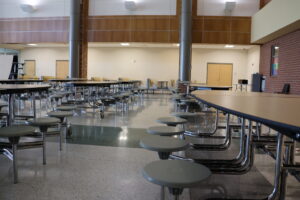At Richmond’s Huguenot High School, students in Ms. Nixon’s English class face the future together. Ninety three percent of Huguenot’s students are either Black or Hispanic, and for every eight students, seven are eligible for the federal free lunch program. (Photos by Bettina Johnston)
By Anna Ridilla and Bettina Johnston
Between 9 a.m., when the first class bell rings, and the 4 p.m. bell to head home, there are a lot of hungry teenagers at Huguenot High School in Richmond, VA. Even with a full-service cafeteria and funding from the federal school lunch program, the school finds it hard to feed its population of nearly 1,400 [1,389] growing teenagers, many of whom bring nutritional deficits from home.
“It is difficult for many of the students to get through long class blocks,” said Gwendolyn Nixon, an award-winning English teacher. “I’m not saying that they never eat [at home], but they don’t have the nutrition that is breakfast, lunch and dinner – they don’t have that consistency. That’s why our lunches are free or reduced.”
“The hungry kids often present as the ‘bad’ kid,” she continued. “They’re acting out, they’re off task, they’re disgruntled, irritated, restless.” It can sometimes be difficult to get through to these students because it is hard to understand if it is the eating issue, a sleep issue or if they just don’t understand the material, Nixon said.
Huguenot is a Title I school, a program that provides financial assistance to public schools with high numbers of students from low-income families. These schools receive federal funds to serve free and reduced breakfast and lunch, which must meet federal nutrition standards for school meals. Other students opt to bring their own lunch or snacks from home.

Huguenot’s cafeteria serves up to 200 students at a time, which often leads to long lunch lines and certain food options running out. On the day we visited, the cafeteria had run out of pepperoni pizza, a popular item, by the last lunch period.
Each lunch period last 25 minutes-“too short,” according to nearly every student we talked to. “Sometimes the line – if there are a lot of people – it takes longer, and so by the time you’re sitting down you have like ten minutes to eat,” one student said.
There are two vending machines in the cafeteria that advertise options such as yogurt and sandwiches, but the day we visited, every shelf was empty. On a table near the vending machines was a microwave – added, Nixon explained, after students complained about cafeteria lunches being served cold. The microwave allows students to heat them.
Drink options at lunch consist of milk and juice, while food choices are limited to pizza, chicken sandwiches, cheeseburgers and the occasional salad.
The block right before lunch is the most difficult to get through, one student said. Some teachers allow students to eat in the classroom and snack throughout the day, but not all are that permissive.
Gabe Segal has met similar challenges as a science and special education teacher at Herndon Middle School in Fairfax. He first noticed food insecurity at school during the COVID-19 pandemic.
“We have organizations that help us, but sometimes it’s just not enough,” Segal said. “Just seeing a kid with their head down. They’ll do anything for food. You can incentivise them to come to school everyday. They’re always asking for food. It’s not like they’re not offered the food – they are – that just tallies up debt.”
Segal has been working to raise money to pay off families’ school lunch debt because free and reduced meal programs help, but don’t reach everyone, he said.
Food insecurity affects kids academically, behaviorally and mentally, Segal added. A 2005 study from the Journal of Nutrition established the significant relationship between household food insecurity and children’s academic, social and physical development.
Like Ms. Nixon at Huguenot, he finds it challenging to teach kids who are hungry. “I think it’s two factors. They’re not eating breakfast, and they’re also not getting enough sleep.”
It can take a lot of prompting and reminders to get them up and paying attention, he says. “If they have breakfast it can make a difference.”
